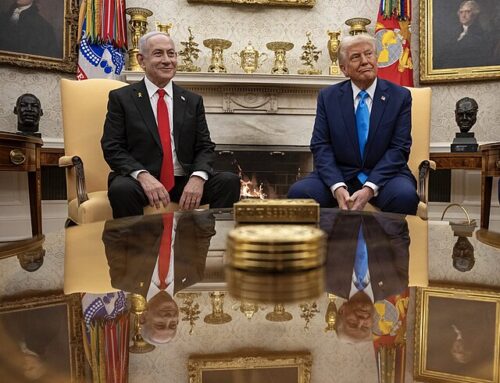Abbas & Olmert in Nov. 2008 … The latest installment in this melodrama, according to Jonathan Tobin of Commentary, was Ehud Olmert’s offer to Mahmoud Abbas in September of 2008, which Abbas presumably rejected. Olmert’s “lesson” should not be lost on John Kerry and “American and Jewish apologists” who think the peace process is worth our time, or that, oh, I don’t know, things like settlements are obstacles to peace.
And the occasion for Tobin’s reinforcement of Olmert’s lesson is the latter’s new interview with Avi Issacharoff in The Tower, provocatively entitled “Exclusive: Olmert: ‘I Am Still Waiting For Abbas To Call.'” “For the first time,” Issacharoff reports, “Olmert himself is revealing the full details of the proposal,” a peace plan “the Palestinians rebuffed.” …The language here is so impacted with narcissism, … there is nothing–zero, nada, zip!–in the Olmert interview with Issacharoff that Olmert did not detail for me and The New York Times Magazine over two years ago, or simultaneously reveal in his Hebrew memoir, or broadly imply to others before me. . .. . . On the contrary, both Abbas and Olmert emphasized to me that neither side rejected the plan; both understood that they had the basis for a continuing negotiation. Abbas made clear, as did Saeb Erekat, that the Palestinian side accepted … security arrangements acceptable to Olmert.
The Palestinians also accepted the principle that the Holy Basin would be under a kind of transnational custodianship. The sides agreed to refer to the Arab Peace Initiative … to launch negotiations about the number of Palestinians who’d come back to Israel under the “right of return.”
They did not agree yet on a number; and, swap or no swap, Abbas did not accept the border as Olmert had mapped it out, with Ariel, Maaleh Adumim, and Efrat–that is 5.9% of the West Bank–incorporated into Israel. The Palestinians wanted a plan in which 1.9% would be Israeli, which would allow 62% of settlers to remain in place. But closing such gaps is what just American mediation would be for. In fact, negotiations to close them did ensue, though informally, at the Baker Institute at Rice University, where former Israeli officials and one of Palestine’s negotiators, Samih Al-Abid (whom I also interviewed), floated ideas in the 4% range.
Why did Abbas not come back immediately with a counter-proposal? Well, from Abbas’s point of view, Olmert’s was the counter-proposal. Erekat had proposed 1.9%. Abbas hoped Obama would be elected and some new mediator might be more sympathetic to the Palestinians when it was time to close the deal. Yes, there is continuing disagreement between Olmert and Abbas about why that negotiation did not ensue, formally, and immediately, after Olmert’s offer on September 16; or why the sides did not meet in Washington during the first week in January, 2009. Erekat insisted to me that he was willing to go to Washington to meet with Shalom Turgeman, in spite of the Gaza operation, and that Condoleezza Rice could confirm this; Olmert says the invitation was muddled and, besides, this was all too late.
Suffice it to say that Abbas first wanted to see if Obama would indeed be elected. But then the border with Gaza started heating up, and Olmert, though already a lame-duck, thought he could actually advance peace (and help Abbas, in a way) by undermining Hamas’s strategic capabilities along the Philadelphia Corridor. Then, the sheer bloodiness of the war eclipsed everything; and by the time the two leaders might have come together, revulsion for Israel’s leaders on the West Bank, and Livni’s emergence as Olmert successor, etc., made Olmert’s and Abbas’s plans moot.
The one story Issacharoff does reveal for the first time to English audiences–which is lovely, and I could not use for reasons of space–is how Olmert first got Abbas to come to the Prime Minister’s residence late in 2006, that is, by telling him that his wife had prepared all of his favorite dishes and that Abbas would insult her by not showing up. However, the real poignancy of this story has a background Issacharoff does not reveal, namely, that Olmert (so he told me) had been in several meetings with Abbas and Olmert’s predecessor, Ariel Sharon, in which Sharon treated Abbas so bullyingly that Olmert himself cringed but, alas, had to remain silent; that Olmert knew he would have to make a gesture to Abbas to prove he was not approaching things as his former boss did.
Which brings me to the main point. There was, and is, no disagreement between Olmert and Abbas that American diplomacy might have picked up from where they had left off. They also agreed that it was Netanyahu who said “No way” as soon as he came into office in the spring of 2009. …
A final caveat. I don’t meant to imply that the “core issues” Olmert and Abbas dealt with are the final ones. I have argued here and elsewhere that the confederal approach the two leaders tipped-toed up to in Jerusalem, over security, the international commission on refugees, etc., will have to be deepened and expanded if a two-state solution will ever be made plausible. … Good faith can produce creative plans for reciprocity and greater integration. Olmert is surely right about the need, at times, for “creative ambiguity” in reconciling practical interests. . . .




Truly no matter if someone doesn’t know afterward its up to other people that
they will help, so here it takes place.